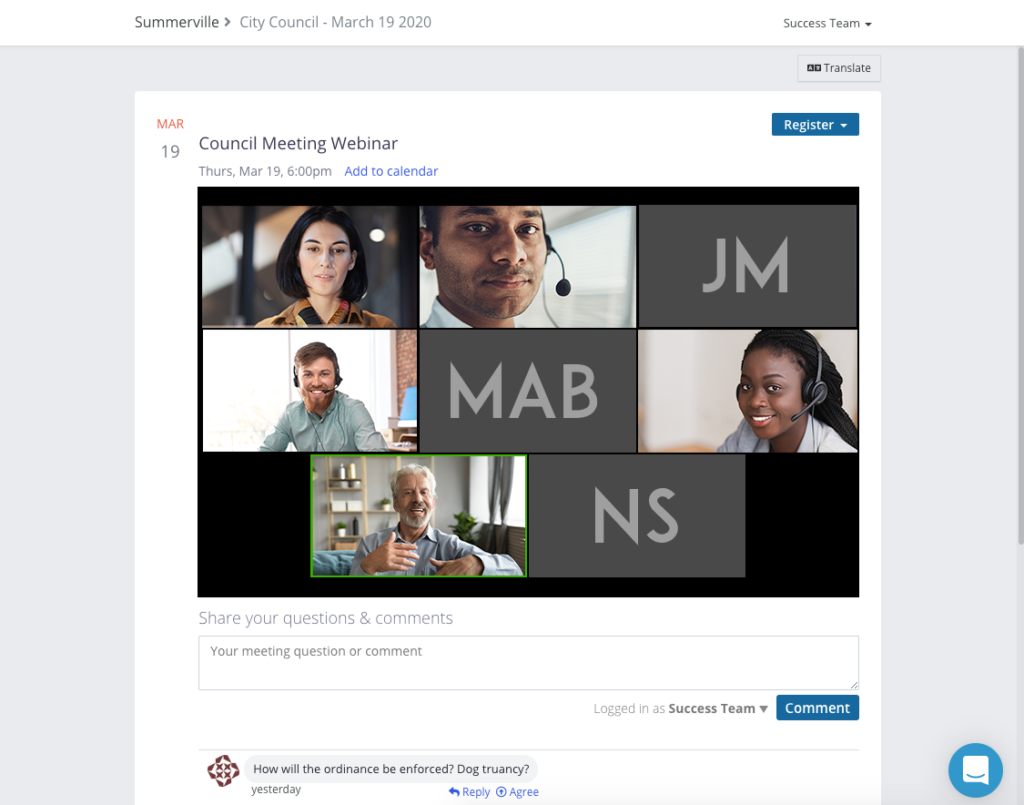In light of the coronavirus, government organizations are finding themselves in a new landscape when it comes to public engagement. Local, regional, and state governments face two major challenges:
- How can we keep key public processes in place if we can’t hold meetings?
- How can we communicate quickly and consistently with residents with pertinent information related to COVID-19?
Many are turning to virtual public meetings while also deploying communication around email, text/SMS, and social media.
How can I host meetings, virtually?
What about our existing conferencing tools?
While a step in the right direction, tools like Zoom and Webex come with severe tradeoffs that make them a tough sell if you want to be inclusive:
- A steep barrier to entry: If they don’t have a newer browser, residents may need to download a mobile or desktop app and may have to create usernames/passwords
- Limited participation: Many platforms only have a limited number of seats, reducing access
- A lack of organization: Difficult to manage and moderate meetings.
- Difficult to manage contacts & comments: Without the right approach, webinars can easily become a one-way conversation, do not catalogue and memorialize comments, and make it difficult to direct residents to a place to provide input (e.g. a survey page).
What about Facebook Live or Youtube?
Facebook Live and Youtube Live are powerful tools, but on their own come with tradeoffs that make them a tough fit for the current environment:
One presenter: This approach won’t work well if more than one staff member or official will be speaking, or if they’re not all physically in the same room.
Records liabilities: Social media users can delete comments on demand, creating significant public records liabilities if you don’t have a capture mechanism in place.
A virtual meeting solution should:
- Allow for an unlimited number of participants
- Allow residents to drop-in without a login, password, or download
- Mirror an in-person meeting, including presenting slides and collecting feedback instantly with surveys and commenting
- Allow residents to engage even if they don’t have WiFi access
- Create opportunities for collecting contact information for updates and follow up
Live meeting integrations for Facebook Live and Youtube
In light of the key concerns we listed with these platforms, PublicInput.com has created deep integrations with both platforms to:
- Broadcast publicly on your engagement hub so residents don’t have to log in to participate.
- Embed video alongside structured engagement questions, interactive maps, and FAQ modules.
- Sync via API to capture all comments in your engagement database for records compliance and reporting.

Announcing a new virtual meetings solution
Based on conversations we’ve had with you in the past week, we have developed major innovations that directly address the concerns of council members and staff.
Introducing live integrations for Zoom
Earlier we pointed out the challenges of using conferencing tools – registrations, downloading apps, unstructured dialog, and records retention.
With that in mind, we’re bringing a first-ever integration with popular conferencing service Zoom. This represents a unique solution that allows:
- Multiple remote presenters and unlimited attendees
- Screen sharing for presentations
- Easy, no-login access for the general public
- Real-time comments and questions using the PublicInput.com engagement hub
This solution is being rolled out to a select subset of our partners for beta testing and will be made available to all clients on a rolling basis.

Phone-in Comments With Automatic Transcription
Not all residents will feel comfortable providing comments online, or may prefer to call to weigh in on a topic. This week we’re excited to launch voice integrations directly from your project dashboard. All comments left by voice will automatically be transcribed and added to your comment feed:

Launch your Virtual Meetings Toolkit within 24 hours:
Want to see examples of how organizations are taking meetings online?
We recently hosted “Communication During Coronavirus” which covered tactics for keeping key public processes in place:
- Moving public meetings online and hosting virtual town halls
- Quickly deploying an online engagement hub for residents
- Creating targeted social media campaigns to build awareness and subscriber lists
- Setting up real-time text message alerts and automated replies
The playbook for public engagement during coronavirus:

This playbook is an interactive example of strategies for continued communication during coronavirus, and in the future. This includes: virtual meetings, landing pages, event announcements, and email/text subscriber forms all integrated in one place:
1. Keep your process intact and continue public engagement while still implementing best practices and complying with mandates
2. Connect with residents with pertinent information related to COVID-19
A customizable engagement hub to meet the needs of your organization:
- Embed directly into your organization’s existing website
- Collect email and text subscribers — connect directly with residents, consistently
- Livestream public meetings — Collect comments and broadcast directly from the engagement hub and integrate with Zoom, Facebook Live and YouTube
- Drive traffic with targeted social media, SMS outreach, and email — establish yourself as the main source of information for residents.



